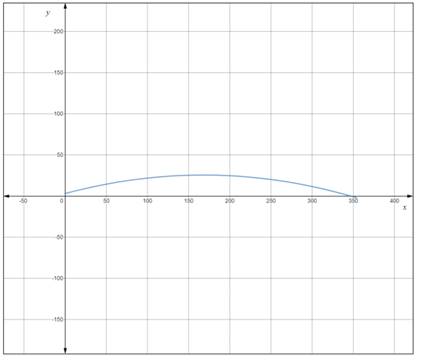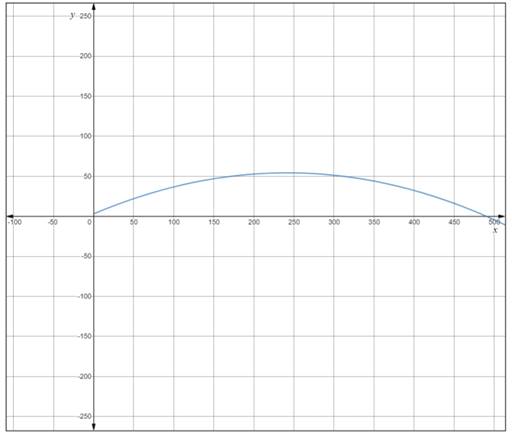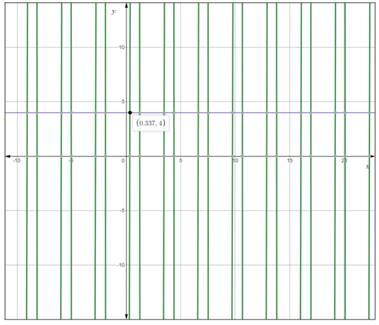
Concept explainers
a.
To write a set of parametric equations that model the path of the baseball.
a.
Answer to Problem 63E
Explanation of Solution
Given: The ball is hit at a point 3 ft above the ground at an angle
Calculation:
The velocity of the ball in feet per second can be given as
Therefore, the parametric equations for the path of the ball can be given as:
That is,
b.
To graph the path of the ball when
b.
Explanation of Solution
Given:
Graph:
The parametric equation for
Now, graph these parametric equations using graphing utility as shown below.

From the graph it can be seen that the ball hits the ground at a distance of around 350 ft. So, it is not a home run.
c.
To graph the path of the ball when
c.
Explanation of Solution
Given:
Graph:
The parametric equation for
Now, graph these parametric equations using graphing utility as shown below.

From the graph it can be seen that the ball hits the ground at a distance of around 490 ft. The height of the ball at a distance of 408 ft is around 13 ft. So, it is a home run.
d.
To find the minimum value of the angle
d.
Answer to Problem 63E
Explanation of Solution
Given: The parametric equations
Calculation:
The home will be hit if
Now,
And,
Now, find the solutions of this inequality, graph the equations

From the graph it can observed that the equation
So, the minimum angle required to hit a home run is
Chapter 9 Solutions
PRECALCULUS W/LIMITS:GRAPH.APPROACH(HS)
- Find the accumulated amount A, if the principal P is invested at an interest rate of r per year for t years. (Round your answer to the nearest cent.) P = $3800, r = 4%, t = 10, compounded semiannually A = $ 5645.60 × Need Help? Read It SUBMIT ANSWER [3.33/6.66 Points] DETAILS MY NOTES REVIOUS ANSWERS ASK YOUR TEACHER TANAPCALC10 5.3.001.EP. PRACTICE ANOTHER Consider the following where the principal P is invested at an interest rate of r per year for t years. P = $3,100, r = 4%, t = 10, compounded semiannually Determine m, the number of conversion periods per year. 2 Find the accumulated amount A (in dollars). (Round your answer to the nearest cent.) A = $ 4604.44arrow_forwardForce with 800 N and 400 N are acting on a machine part at 30° and 60°, respectively with a positive x axis, Draw the diagram representing this situationarrow_forwardI forgot to mention to you to solve question 1 and 2. Can you solve it using all data that given in the pict i given and can you teach me about that.arrow_forward
 Calculus: Early TranscendentalsCalculusISBN:9781285741550Author:James StewartPublisher:Cengage Learning
Calculus: Early TranscendentalsCalculusISBN:9781285741550Author:James StewartPublisher:Cengage Learning Thomas' Calculus (14th Edition)CalculusISBN:9780134438986Author:Joel R. Hass, Christopher E. Heil, Maurice D. WeirPublisher:PEARSON
Thomas' Calculus (14th Edition)CalculusISBN:9780134438986Author:Joel R. Hass, Christopher E. Heil, Maurice D. WeirPublisher:PEARSON Calculus: Early Transcendentals (3rd Edition)CalculusISBN:9780134763644Author:William L. Briggs, Lyle Cochran, Bernard Gillett, Eric SchulzPublisher:PEARSON
Calculus: Early Transcendentals (3rd Edition)CalculusISBN:9780134763644Author:William L. Briggs, Lyle Cochran, Bernard Gillett, Eric SchulzPublisher:PEARSON Calculus: Early TranscendentalsCalculusISBN:9781319050740Author:Jon Rogawski, Colin Adams, Robert FranzosaPublisher:W. H. Freeman
Calculus: Early TranscendentalsCalculusISBN:9781319050740Author:Jon Rogawski, Colin Adams, Robert FranzosaPublisher:W. H. Freeman
 Calculus: Early Transcendental FunctionsCalculusISBN:9781337552516Author:Ron Larson, Bruce H. EdwardsPublisher:Cengage Learning
Calculus: Early Transcendental FunctionsCalculusISBN:9781337552516Author:Ron Larson, Bruce H. EdwardsPublisher:Cengage Learning





